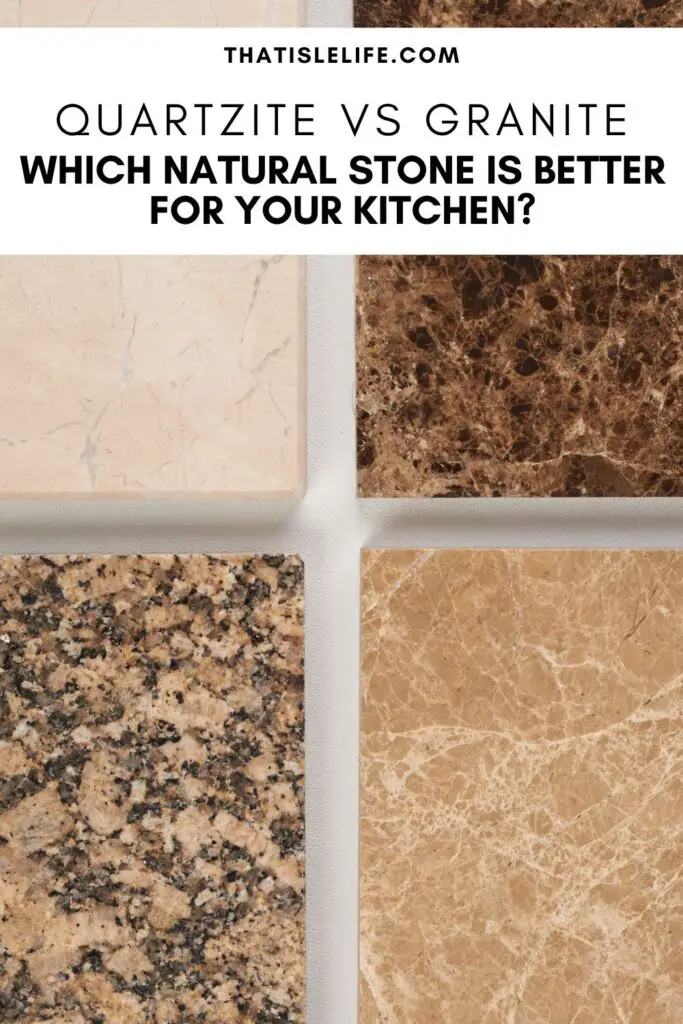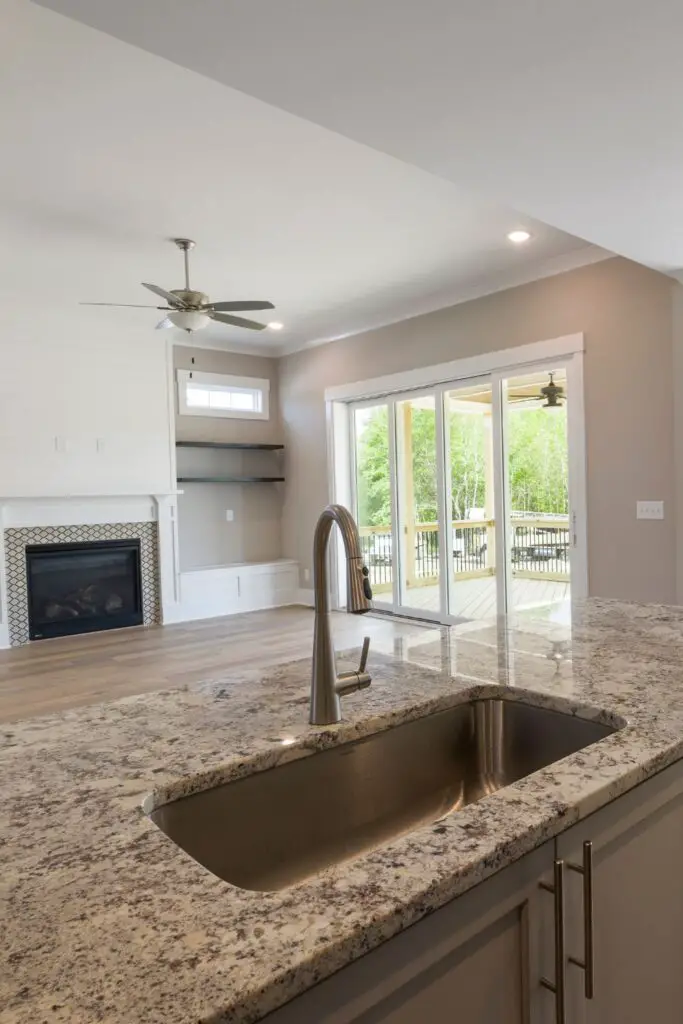Are you torn between quartzite and granite? Both are beautiful stones that are durable, hardy, and 100% natural. So, which stone is better for your kitchen? Keep reading to find out the pros and cons of quartzite vs granite.
Are you renovating your kitchen and looking for a natural stone countertop?
It’s easy to feel overwhelmed when choosing natural stone, especially if you don’t know how each stone differs from the other.
From what I’ve heard, granite is a popular choice for kitchen countertops. However, more people are starting to find its speckled pattern too traditional for their liking.
On the other hand, a lot of people I know have expressed their love for marble but have refrained from installing it because of its high maintenance.
That’s where quartzite comes in. It’s a natural stone that looks like marble, but it is less porous and more durable than marble. In fact, quartzite shares a lot of the amazing qualities granite has.
In this post, I will share everything you need to know about quartzite vs granite – what it is, how it’s made, its uses, and the pros and cons of each stone.
Before we dive into this post, it is important to note that quartzite is NOT quartz. People tend to confuse both materials because their names sound so similar.
Quartzite is a natural stone whereas quartz is an engineered stone. Click here to learn more about quartz!

Related to Quartzite vs Granite:
- Dolomite vs Granite: Which Is Better For Kitchen Countertops?
- Quartz vs Marble – Which is the better option for my kitchen?
- Sintered stone vs Quartz – Which Slab Is Better For Your Home?
What is quartzite?

What it is: According to Geology.com, quartzite is a metamorphic rock made almost entirely out of quartz.
How it’s made: Quartzite is formed when sandstone is altered by Earth’s heat and pressure in addition to the chemical activity of metamorphism.
Texture and finish: Slightly coarser feel, but can come in different finishes like polished, honed, and leathered
Color: Primarily whites and greys
Pattern: Similar to marble as both stones have feathered strokes or swirling veins across the slab
Uses: Kitchen countertops, decorative walls, roofing tiles, stairs, and flooring
Cleaning Instructions: Clean daily with a soft sponge or cloth, gentle soap, and water. For intensive cleaning, use a non-abrasive stone cleaner designed specifically for natural stones.
Maintenance: As with all natural stones, quartzite requires regular sealing to maintain its quality. Use coasters, trivets, and cutting boards to prevent stains, etch marks, and scratches. Wipe all spills immediately with a soft cloth.
Pros of quartzite
Looks like marble
Quartzite’s biggest selling point is that it looks like marble but it’s far more durable than marble. Additionally, it’s less porous than marble. It is also one of the most beautiful natural stones in the market.
More durable than granite
Both granite and quartzite are resistant to wear and tear. They can endure and resist most stains, scratches, chips, and cracks. However, quartzite is slightly more durable than granite. Quartzite measures a 7 on the Mohs scale whereas granite measures a 6 on the Mohs scale.
Heat-resistant
One of the quartzite’s advantages is its heat resistance. Quartzite can withstand hot materials on its surface, making it perfect for kitchen countertops. However, using trivets or hot pads whenever you can is advisable.
Increases house resale value
Being a natural stone, quartzite will increase a house’s resale value. Its appearance plus durability makes it a desirable stone.
Cons of quartzite
Requires regular maintenance
Like all natural stones, quartzite requires regular maintenance like annual sealing. Besides that, it is essential to take precautionary measures such as wiping spills immediately to maintain the stone’s quality.
More expensive than granite
Quartzite is rarer than granite, therefore the former is more expensive than the latter. Quartzite starts from $60 per square foot whereas granite starts from $40 per square foot. However, prices for both stones vary depending on other factors like location, slab thickness, color, etc.
What is granite?

What it is: Accordingly to Geology.com, granite is an igneous rock that contains quartz, feldspar, and other minerals.
How it’s made: As an igneous rock, granite is formed from the solidification of molten rock material. In other words, granite is formed from the crystallization of magma below the Earth’s surface.
Finish: Granite comes in three finishes namely honed, polished, and leathered.
Color: Granite comes in a wide range of colors. Popular colors include white, beige, brown, and black.
Pattern: Granite has 3 primary patterns – speckled, solid, or marble. You can spot a speckled granite instantly because of the metallic-hued flecks or spots in the pattern. Solid, as its name applies, refers to granite that comes in one single hue with a little pattern on it. Lastly, marbled granite looks similar to marble as it has organic and unique veining across the stone.
Uses: Kitchen countertops and backsplashes, bathroom countertops and backsplashes, flooring, mantelpieces, and staircases
Cleaning Instructions: Clean daily with a soft sponge or cloth, gentle soap, and water. For intensive cleaning, use a non-abrasive stone cleaner designed specifically for natural stones.
Maintenance: As with all natural stones, granite requires annual sealing to maintain its quality. Use coasters, trivets, and cutting boards to prevent stains, etch marks, and scratches. Wipe all spills immediately with a soft cloth.
Pros of granite
Affordable
Since there is an abundant supply of granite, it is more affordable than other natural stones like quartzite and marble.
Durable
Granite is considered to be one of the most durable natural stones on the market. It. doesn’t chip or crack easily, and it’s also scratch and stain resistant.
Heat resistant
Like quartzite, granite is heat-resistant. You don’t have to panic if you forget to use a trivet when taking out a hot pan, as it probably wouldn’t damage your granite countertop.
Wide range of colors
This is where granite triumphs over quartzite. Since granite comes in a wide range of colors and patterns, the options are endless!
Cons of Granite
Requires maintenance
Like quartzite, granite requires regular maintenance. It is necessary to seal granite annually if it is used frequently. Protecting your natural stone will help it to last for years.
Quartzite vs Granite: Which Natural Stone Is Better For Your Kitchen?
While quartzite and granite may look different, they are more similar than one may think!
Choosing between quartzite and granite ultimately comes down to two things: appearance and budget.
If you like the look of marble with the durability of granite, quartzite is a great option. Just be prepared to fork a little extra for this beautiful and durable stone.
If budget is an issue, stick to granite. Since there are so many options in the market, you’ll definitely find something you like!
Choosing a natural or engineered stone for your home? Check out these popular tips below:
- Dolomite vs Granite: Which Is Better For Kitchen Countertops?
- Quartz vs Marble – Which is the better option for my kitchen?
- Travertine vs Marble – What’s the difference and which is the better option for my home?
- Terrazzo vs Marble – Which is the better option for your home?
- Sintered Stone vs Quartz – Which Slab Is Better For Your Home?

